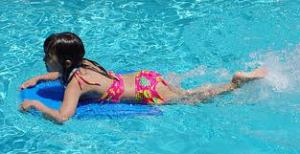Riding a kick board on your tummy helps develop head and visual control as well as lateral trunk control for better core stability. Children gain in their gross motor skills, stimulate their sensory input and improve overall physical development.
- Place your child on his or her belly with the kick board supporting the trunk from armpit to pelvis. Put one hand on the lower back and one under the kick board if your child needs support. Shift the board side to side and do circles around you.
Sitting on the board can help develop balance and oblique muscles.
- Place children in sitting facing you as you hold both sides of the board under their bottom. If they do not have enough trunk control to maintain sitting in this position turn them to face away from you. Then bring their trunk and the board against your body and reach around to hold the board between their thighs. Move through the water and tilt the board in all directions to stimulate balance reactions.
Standing on the board is difficult but fun for all and a great way to develop balance and pelvic control.
- Push the board down to a step that your child can stand comfortably on and hold it to the surface with your foot. Holding your child’s hand have them step onto the board on either side of your foot and slowly allow the board to rise or slide off the step. Watch out for the flying board when it pops out from underneath.
KEY words: Core strength, pediatric physical therapy, aquatic therapy, special needs, childhood development, gross motor skills.
All content the property of PEDI Center for Therapy. Improper use may result in legal action.
Related articles
- Aquatic therapy improves coordination, sensory integration (pedicenterfortherapy.wordpress.com)














 First Connections/JRI
First Connections/JRI